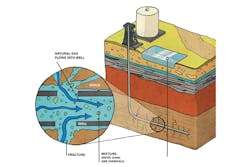Hydraulic fracturing would not be as widely practiced today if not for the recent development of new horizontal drilling tools and techniques, which have opened up very-deep rock formations previously inaccessible using traditional vertical drilling. This is particularly valuable with shale rock formations, such as the Bakken, which at about 2 miles is too deep and lacks sufficient permeability for traditional vertical wells to operate economically.
In 2005 before the advent of horizontal drilling and hydraulic fracturing, the Bakken formation in North Dakota produced just 3,000 barrels of oil a day. By the end of 2014, North Dakota was producing close to 1.2 million barrels of oil per day. To give perspective on such production, in 2014 the U.S. consumed the equivalent of 19.11 million barrels of oil a day, according to the U.S. Energy Information Administration.2
Contrary to popular belief and the popular brand of a national gas service station, oil and gas are not formed from the remains of dinosaurs. Instead, they are mostly derived from microscopic marine organisms called plankton. Millions of years ago, much of the world, including most of the U.S.’s Central Plains states as well as Texas and California, were covered by a vast sea. As the plankton living on the surface of this sea died, they would fall to the sea floor, where they became an organic mush.
Some of the deeper sections of this ancient sea lacked oxygen, which enabled the dead plankton to build up, layer upon layer over millions of years. Eventually it formed a rock layer known as black shale with a dark color derived from decomposed organic material. This is how the Bakken formation and other shale-based formations began. As the Bakken shale became buried under more and more layers of organic material and sediment, it began to heat up, undergoing chemical and physical changes and eventually transforming into natural gas and oil.
Unlike with most other types of rock formations, the gas and oil in black shale stayed in place for millions of years – until hydraulic fracturing and horizontal drilling made access to this hydrocarbon-rich trove possible.
Snehal Desai is the global business director for Dow Water & Process Solutions. He is responsible for implementing the company’s business growth strategy and leading 1,700 people. Desai is an expert on industry and global issues such as water scarcity, quality and safety along with the interdependencies of water and energy.
Aaron M. Johnson is the growth technology leader for Dow Water & Process Solutions’ Oilfield Water platform. Since 2009, he has been responsible for establishing and leading programs to develop and commercialize solutions to water challenges facing the hydrocarbon exploration and production industry. His research efforts include new products, as well as application-driven research on membranes, ion exchange and specialty adsorbent technologies.
Resources
- North Dakota Department of Mineral, www.dmr.nd.gov/oilgas/stats/historicalbakkenoilstats.pdf.
- U.S. Energy Information Administration, Frequently Asked Questions: How much oil is Consumed in the United States, Updated: September 14, 2015, http://www.eia.gov/tools/faqs/faq.cfm?id=33&t=6.
